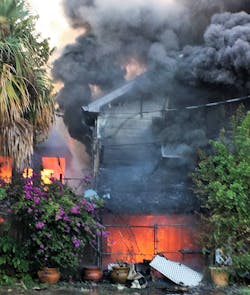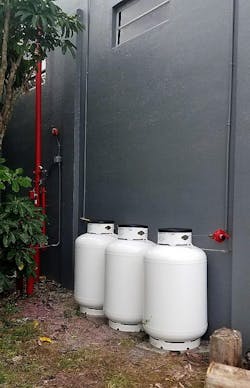First-arriving units have many things to think about during their initial size-up. Their quick arrival report should include the dwelling type, its construction, and the conditions, actions and needs. This information would go over the radio to paint a picture for incoming units.
The acronyms “COAL WAS WEALTH” and “WALLACE WAS HOT” have been utilized as a tool for size-up, but each involves a lot of information to handle for a first-on-scene decision-maker. In the incident command system (ICS), we like the span of control to be between 3 to 7—preferably 5—because it is a management tool to handle all response-related work. It’s easier to manage and remember than if you are responsible for 15. Although every aspect of those acronyms is important, it’s a lot to be processing for a first-arriving unit that must handle multiple responsibilities: give an arrival report, do a size-up, force entry, search and perform hose management for fire attack. The departments that have too few personnel on scene are far more numerous than the departments that have too many.
I would like to introduce “CLUES” as an acronym that’s user-friendly and that covers the 360 walk-around information that’s needed for the first-arriving officer. CLUES is the first size-up acronym that takes into account information from the thermal-imaging camera (TIC).
CLUES is used for Conditions, Location, Utilities, Exposures and Survivable (tenable) spaces.Conditions
Conditions includes smoke conditions, fire conditions and weather conditions. Smoke conditions should be used to read location and travel direction using volume, velocity, density and color. With this information, we can see the stage of the fire, the location of the fire and the travel direction of the fire.
The fire conditions could be described as through the roof, out of one window, fully involved or something such as full Alpha-side involvement. Make sure to read the smoke first then the fire, because the fire is bright, and one’s eyes go to it quickly without reading the danger signs that the smoke tells you.
Weather conditions are needed to recognize wind speed and direction. This is particularly important with the potential of wind-driven fires and flow-path management. Remember door control upon arrival. If entry doors are open, peek inside for victims then close the doors until you’re ready to enter.
Location
This is where the TIC gets put to work. You’re looking for the location of high heat accumulation, heat travel location or flow path as well as the percentage of the building that’s involved, to estimate the gallons per minute (gpm) that’s needed to absorb the energy that the fire is giving off.
For high heat accumulation, look for the thermal signatures in the structure: the heat signatures (bright white or colorized on TIC) in window frames and walls to determine the direction of travel using the thermal signatures from your TIC. The high heat concentration will be the fire location, and, as the fire travels, the heat signature will thin out to follow the travel direction. If one part of the wall has 50 percent of a heat signature from the ceiling and, farther down, the same wall has a 20 percent heat signature, you just found the travel direction of the heat, or the flow path.
Using the fire flow formula (LxW/3), you could estimate whether this is something that your 1¾-inch hose can handle with 160 gpm, or do you need your 2½-inch for 265 gpm? If the fire is in the Bravo/Charlie corner and you have thermal signatures of 20 feet on the Bravo wall and 20 feet on the Charlie wall, 20x20/3=133 gpm.
Using the TIC can help you to find your best access to the location of the fire. On your walk-around, if you find the heat build-up on the Bravo/Charlie corner, it might be easier to go through the Charlie side kitchen door than it would be to maneuver a hoseline from the front entry to the back of the house. Making entry closest to the heat source will assist in making a quick knock down and improving conditions.
Utilities
This reminds you to control electricity, natural gas and propane during your walk-around.
You also should utilize this opportunity to power down generators. Because many generators automatically power the house after electricity is turned off, this could create a safety hazard for you as you fight the fire.
It’s necessary to locate all of these items to determine whether they will interfere with access and/or add to hazards.Also, regarding utilities, think about your ladder truck placement. Where are the utilities located? If the electric lines are on the Delta side of the structure, you should consider setting up on a different side. This information should be given to the truck company prior to their arrival, so they can plan their approach accordingly.
Do you see electric lines down? Are they on a fence? Use your TIC to check the fence for heat signatures.
Is there a propane tank on the same wall that the fire is located?
These are items that the incident commander (IC) needs to be informed of and need to be controlled.
Exposures should be categorized as immediately or eventually. If immediately, consider fast water on that exposure. The engineer could set up a deck gun or a ground monitor to keep the exposure safe while others continue their tasks. If eventually, remember this, and pass on this information to the incoming IC.
Survivable spaces
Prioritize the areas that need to be searched. Remember the “Location” that you found using your TIC? This information could assist you in finding what areas should be searched first. Of course, you know that you should start your search as close to the fire room as possible. Consider VEIS (vent enter isolate search) if you’re unable to get to the closest room. Using your TIC, check for heat signatures in the room, the roof above and the frame around the window. If all is clear and entry is considered possible, continue with your VEIS.When inside of the structure, use an oriented TIC directed or TIC lead search. With TIC directed, the TIC firefighter scans the room and directs the firefighters where to search or where to go. With TIC lead search, the TIC firefighter scans the room, and the firefighters then follow the firefighter who has the TIC. (Both searches require practice, which could be done in your station.)
Remember, start as close to the fire as possible and work your way back while controlling the flow path by closing the doors.
For smaller departments, the first-arriving officer will complete radio size-up, perform a 360 walk-around, and begin operations as required based on needs and priority. The engineer serves as IC until the battalion chief or next officer arrives on scene.
Using CLUES with the TIC makes the job easier for the first-arriving officer. It improves water-on-the-fire times, finds the easiest access to the fire and discovers those survivable spaces that need to be searched first to enhance life-saving probabilities.
About the Author

Joseph DeVito
Joseph DeVito is a captain in Florida who has more than 25 years in public service. He has worked at volunteer organizations and as an EMT-P for a county-run EMS department and has been at his current department for 18 years. DeVito is Level 1 IR-certified and holds the Fire Officer credential from the Center for Public Safety Excellence. He loves teaching thermal imaging, which is a tool that he believes is under-utilized in the fire service.




